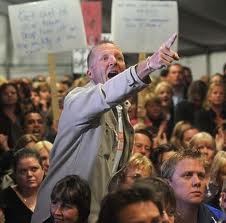In the wake of the Tucson shootings, the theme of the news has been the need to tone down the hostile rhetoric in politics and in society in general. The Pima County Sheriff sounded the alarm first when he cited the “vitriol” in our society as being a contributing factor to such acts of violence. His words hit a chord, there was a collective nod of agreement, and then the finger-pointing began, trying to identify who’s responsible for all the hostility. And of course, the blaming and the defending were hostile.
My goal in writing this article was to support this need for greater respect and civility in our society and to address the damage that words can do on a personal and societal level. As I wrote, something interesting happened. As I cited examples of people and groups that I thought were contributing to the problem, my words got antagonistic and blaming, and my tone became self-righteous. I started over, this time trying to be more neutral. Within a few sentences, the same thing happened. I got hostile writing about hostility!
 So how am I supposed to respond? After all, my first response to hostility toward me or toward a person or cause I support is to become defensive, which easily turns into retaliation. As much as I think of myself as a conciliatory person, I can generate some pretty mean thoughts with the tiniest spark of provocation.
So how am I supposed to respond? After all, my first response to hostility toward me or toward a person or cause I support is to become defensive, which easily turns into retaliation. As much as I think of myself as a conciliatory person, I can generate some pretty mean thoughts with the tiniest spark of provocation.
President Obama, in his speech in Tucson, said, “We are far too eager to lay the blame at the feet of those who happen to think differently than we do.” I think he nodded at me when he said that. It’s much easier for all of us to focus on the causes or on those we believe are responsible for all the hostility. It’s much more difficult to simply do my part to stop the cycle of hostility, regardless of who started it.
So again, how am I to respond when my neck hairs are standing up? I have learned that I first have to breathe and remember some things. I have to remember that hostility, my own or someone else’s, is always based in fear. All the red-faced yelling and stomping and posturing are about feeling threatened. If I respond in kind, there is never a resolution. Hostility simply reinforces hostility because it confirms our fears.
Some of my hostile therapy clients taught me a thing or two. I remember one who said, “This isn’t helping. You don’t know what the hell you’re doing.” His fears of me or of the change I represent are confirmed if I get defensive, “Oh yes I do,” or self-righteous, “Hey, I’m here to help you.” If, on the other hand, I manage to keep my wits and respond to his fear with respectful curiosity, such as, “You’re right, this hasn’t been easy for either of us. There’s a lot about you I don’t understand yet,” we might get somewhere.
I must somehow disengage from the hostility. Otherwise I get caught in it. “Disengage” doesn’t mean I ignore or deny the fear and the anger. It means I see it for what it is and choose instead to engage with the person with respect, with curiosity, and openness to what they have to say.
Even as I write these words, I’m saying to myself, “Good idea, John, but can you really do that?” Hostility seems so “built-in” to our national discourse these days. Of course we can do something. But we must give up the idea that we have to be right and that others therefore have to be wrong. We must embrace the idea that we each have something to learn from the other, even the other who is so different we get scared. It also requires that we keep our mouth shut until we have heard the other person fully and clearly rather than jumping in as soon as we have formulated a rebuttal. That’s the hard part. It’s far easier just to blame.
Printed in the Abilene Reporter News Sunday, January 16. 2011
0 Comments until now
Add your Comment!